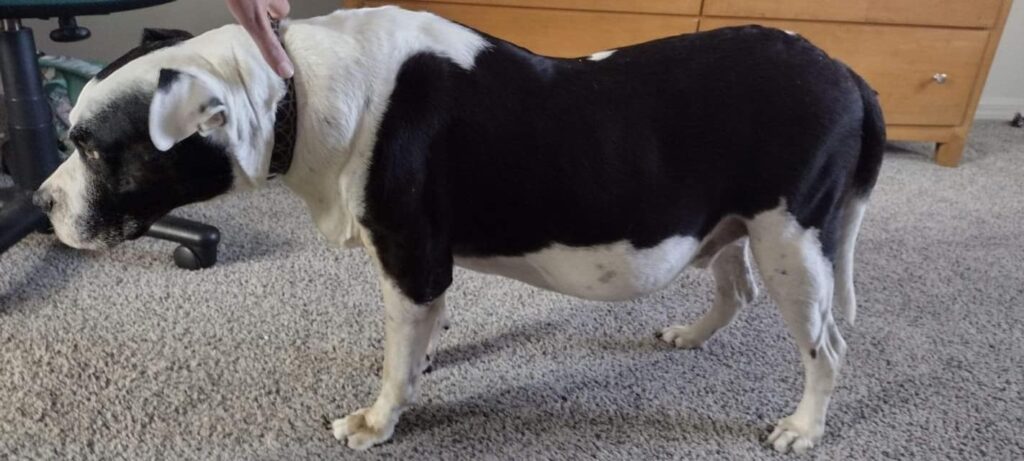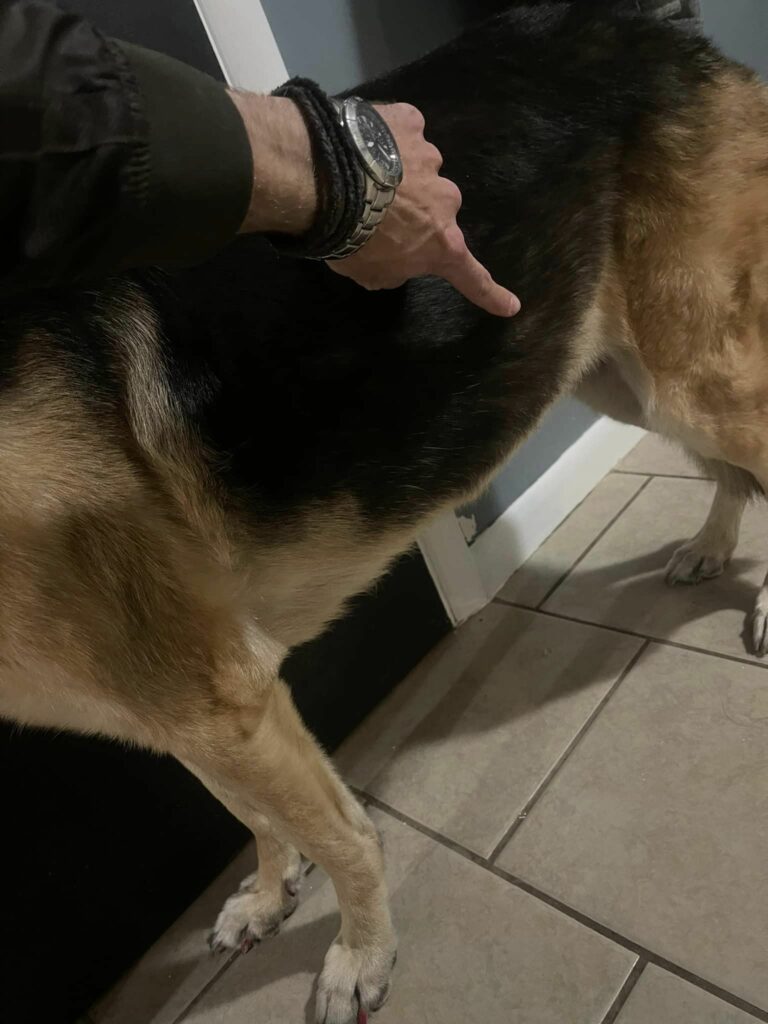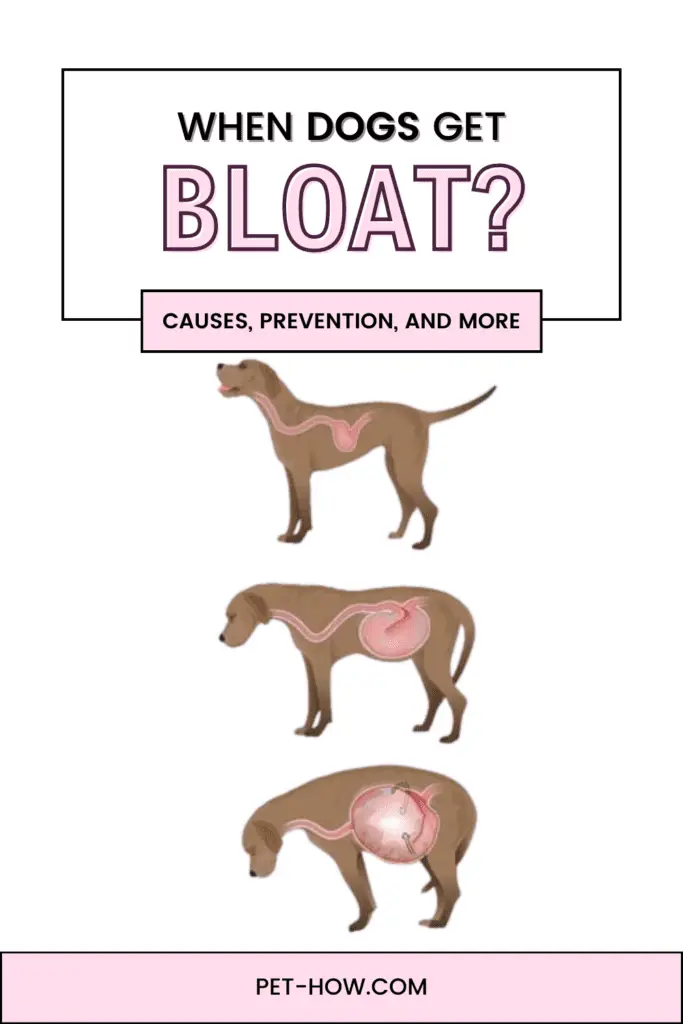Bloat, also known as canine gastric dilatation-volvulus (GDV), is a serious medical condition. It can affect dogs of any breed and age, but some dogs are more at risk than others.
It occurs when the stomach fills with gas or fluid and then rotates on its axis, leading to potentially life-threatening complications.
If you’re a dog owner, it’s essential to understand the signs, risk factors, and prevention strategies related to bloat to keep your furry friend healthy and happy.
In this article, we’ll answer the question, “At What Age Do Dogs Get Bloat?” and provide information on how to recognize the signs of bloat, mitigate the risk factors, and seek appropriate treatment.
- Key Takeaways:
- Feed smaller, more frequent meals
- Use slow-feeders or puzzle toys
- Avoid strenuous exercise immediately after meals
- Monitor water intake
- Consider a preventive gastropexy
- Bloat Surgery Recovery
- Q: At what age do dogs get bloat?
- Q: What are the signs of bloat in dogs?
- Q: What are the risk factors for dog bloat?
- Q: What are the common causes of bloat in dogs?
- Q: How can the risk of bloat in dogs be reduced?
- Q: What are some preventive measures for dog bloat?
- Q: What are the treatment options for dog bloat?
Key Takeaways:
- Bloat, or canine gastric dilatation-volvulus (GDV), is a serious medical condition in dogs that can lead to potentially life-threatening complications.
- Dogs can develop bloat at any age, but it is most commonly seen in middle-aged and older dogs.
- Understanding the signs, risk factors, and prevention strategies related to bloat is essential for maintaining your dog’s health and well-being.
At What Age Do Dogs Get Bloat?

Dogs can develop bloat, at any age, but dogs between the age of 7 and 12 are at higher risk.
Large and deep-chested breeds are more prone to getting bloat.
| Risk Factor | Age Group |
|---|---|
| Breed Predisposition | Giant and Large Breeds, Especially Those with Deep Chests |
| Gender | Male Dogs |
| Feeding Habits | Dogs that eat one large meal per day or eat rapidly |
| Activity Level | Dogs that engage in strenuous activity immediately after eating |
It is important for dog owners to be aware of the signs of bloat and seek immediate veterinary attention if they suspect their dog may be affected.
Signs of Bloat in Dogs

Bloat in dogs is a serious condition that requires prompt veterinary attention. Recognizing the signs of bloat can help pet owners seek care early and potentially improve their dog’s prognosis. Here are some common signs and symptoms of bloat in dogs:
- A swollen or distended abdomen
- Restlessness or pacing
- Unproductive attempts to vomit
- Drooling or salivating excessively
- Refusal to eat or drink
- Rapid breathing or panting
- Pale gums
- Weakness or collapse
If a dog exhibits any of these signs, it’s important to contact a veterinarian immediately. Time is critical, and delaying treatment can have serious consequences.
Note: While these signs are common in dogs with bloat, they can also be indicative of other health issues. Only a trained veterinarian can diagnose bloat and provide appropriate treatment.
Risk Factors for Dog Bloat

While any dog can develop bloat, certain breeds are more predisposed to the condition. Large and giant breed dogs, including Great Danes, Standard Poodles, and Saint Bernards, are at a higher risk. Additionally, older dogs and those with a family history of bloat are also more likely to develop the condition.
Dietary factors can also contribute to the development of bloat. Dogs that eat quickly, consume large meals, or drink excessive amounts of water are more prone to the condition. Feeding a single large meal per day has been identified as a potential risk factor, as has exercise shortly after eating.
Other factors that may increase a dog’s susceptibility to bloat include stress, rapid changes in diet, and certain medical conditions like inflammatory bowel disease or pancreatitis.
Dogs with a deep chest and narrow waist, known as a “deep-chested” or “barrel-chested” build, are also more likely to develop bloat.
Common Causes of Bloat in Dogs
Bloat in dogs, also known as canine gastric dilatation-volvulus (GDV), can have various causes. The common causes of bloat in dogs include:
| Cause | Description |
|---|---|
| Eating too quickly | When dogs eat too quickly, they swallow air along with their food, which can lead to bloat. |
| Exercising after meals | Vigorous exercise immediately after a meal can cause food to move too quickly through the digestive system, increasing the risk of bloat. |
| Large meals | Feeding large meals to dogs can cause the stomach to expand, leading to bloat. |
| Excessive water intake | If a dog drinks too much water too quickly, it can cause the stomach to fill up and potentially lead to bloat. |
It’s important to note that while these factors can increase the likelihood of bloat, any dog can be affected regardless of their risk factors. Therefore, preventative measures should be taken to minimize the risk of bloat in all dogs.
Reducing the Risk of Bloat in Dogs
Bloat is a serious condition that can occur in dogs of any age, but there are steps you can take to reduce the risk of it happening to your furry friend. Here are some tips:
Feed smaller, more frequent meals
Instead of feeding your dog one or two large meals, try feeding them smaller, more frequent meals throughout the day. This can help prevent them from eating too quickly, which is a common cause of bloat.
Use slow feeders or puzzle toys
Another way to slow down eating is by using a slow feeder or puzzle toy. These products are designed to make dogs eat more slowly, which can reduce the risk of bloat. Plus, they can provide mental stimulation, which is beneficial for your dog’s overall well-being.
Avoid strenuous exercise immediately after meals
After your dog eats, it’s best to avoid any strenuous exercise or activity for at least an hour. This can help prevent the food from moving around too much in the stomach, which can contribute to bloat.
Monitor water intake
While it’s important to make sure your dog is well-hydrated, drinking too much water too quickly can also lead to bloat. Try to monitor your dog’s water intake and offer it in moderation throughout the day.
Consider a preventive gastropexy
If you have a breed that is more susceptible to bloat, such as a Great Dane or Weimaraner, consider talking to your veterinarian about a preventive gastropexy. This is a surgical procedure that can help prevent bloat by attaching the stomach to the abdominal wall, making it less likely to twist and cause GDV.
Dog Bloat Prevention
Preventing dog bloat requires a proactive approach that takes into account your dog’s individual risk factors and lifestyle. Here are some strategies that can help minimize the risk of bloat:
- Feed smaller, more frequent meals: Rather than feeding your dog one or two large meals a day, try breaking up their feedings into three or four smaller meals. This can help prevent them from eating too quickly and swallowing excessive amounts of air.
- Use slow feeders or puzzle toys: Certain types of feeding bowls or interactive toys can help slow down your dog’s eating and promote healthy digestion.
- Avoid strenuous exercise after meals: Wait at least an hour after your dog has eaten before engaging in any kind of vigorous activity or exercise.
- Monitor water intake: While it’s important to keep your dog hydrated, allowing them to drink large amounts of water at once can increase the risk of bloat. Instead, offer water throughout the day in smaller amounts.
- Avoid certain types of food: Dogs that are prone to bloat should avoid foods that are high in fat, soy, and wheat. Speak to your veterinarian about finding a balanced diet that is appropriate for your dog’s needs.
- Discuss preventive surgical options: For certain breeds, such as Great Danes and Weimaraners, preventive surgery may be recommended to reduce the risk of bloat. This involves surgically anchoring the stomach to the abdominal wall to prevent it from twisting. Talk to your veterinarian to see if this option is right for your dog.
By taking these steps, you can reduce the likelihood of your dog developing bloat and ensure their ongoing health and well-being.
Dog Bloat Treatment Options
If you suspect your dog is suffering from bloat, it is imperative to seek veterinary care immediately. The longer the condition goes untreated, the more severe it becomes and the higher the risk of complications.
Upon arrival at the veterinary clinic, your dog will undergo a thorough physical examination and diagnostic tests such as x-rays and blood work to confirm the diagnosis and assess the severity of the condition.
In most cases, emergency surgery is necessary to correct bloat. This involves decompressing the stomach by inserting a tube through the mouth or a needle into the stomach. The veterinarian will then perform a gastropexy, which involves attaching the stomach to the abdominal wall to prevent it from twisting again in the future.
Other supportive treatments that may be utilized in addition to surgery include intravenous fluids, pain management medications, and antibiotics to prevent infection.
Bloat Surgery Recovery
After surgery, your dog will need to be closely monitored and may need to spend several days in the hospital. They will be kept on a strict regimen of pain management, and antibiotics, and gradually reintroduced to a bland diet.
It is crucial to follow all post-operative care instructions provided by your veterinarian carefully, including limiting exercise and monitoring your dog’s appetite and bowel movements. Most dogs recover well from bloat surgery, but there is always a risk of complications. So, it is essential to monitor your pet closely and seek prompt veterinary care if any concerns arise.
FAQ
Q: At what age do dogs get bloat?
A: Bloat, also known as canine gastric dilatation-volvulus (GDV), can occur in dogs of any age. However, it is more commonly seen in middle-aged and older dogs.
Q: What are the signs of bloat in dogs?
A: Some common signs of bloat in dogs include a swollen or distended abdomen, restlessness, drooling, and attempts to vomit without success. It is important to recognize these signs early and seek veterinary attention.
Q: What are the risk factors for dog bloat?
A: There are several risk factors associated with dog bloat, including breed predisposition, age, and certain dietary factors. Certain breeds are more prone to bloat, and factors such as eating too quickly or exercising after meals can increase the likelihood of bloat.
Q: What are the common causes of bloat in dogs?
A: Common causes of bloat in dogs include eating too quickly, exercising after meals, and consuming large meals or excessive amounts of water. These factors can contribute to the development of bloat, but they can be prevented by implementing certain measures.
Q: How can the risk of bloat in dogs be reduced?
A: To reduce the risk of bloat in dogs, it is recommended to feed smaller, more frequent meals, use slow-feeders or puzzle toys to slow down eating, avoid strenuous exercise immediately after meals, and monitor water intake.
Q: What are some preventive measures for dog bloat?
A: In addition to the aforementioned tips, dog owners can minimize the risk of bloat by avoiding certain types of food, feeding a balanced diet, and discussing preventive surgical options with a veterinarian for at-risk breeds.
Q: What are the treatment options for dog bloat?
A: If a dog is diagnosed with bloat, it is crucial to seek immediate veterinary care. Treatment may involve emergency surgery to correct the condition and other supportive treatments as recommended by a veterinarian.
Conclusion
Bloat in dogs, or gastric dilatation-volvulus (GDV), is a serious condition that can have life-threatening consequences. It is important for pet owners to understand the risk factors, common causes, and preventive measures for this condition in order to minimize the likelihood of their dog developing bloat.
By recognizing the signs of bloat early and seeking veterinary attention promptly, pet owners can improve their dog’s chances of a successful recovery.
Simple preventive measures such as feeding smaller, more frequent meals, using slow-feeders or puzzle toys, and avoiding strenuous exercise after meals can go a long way in reducing the risk of bloat.





Leave a Reply